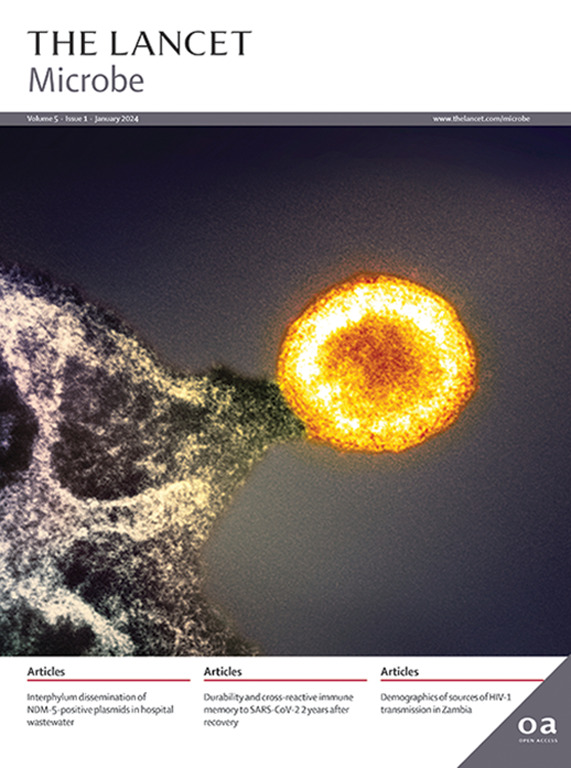北爱尔兰人和禽类甲型流感病毒的废水监测:基因组监测研究。
IF 20.9
1区 生物学
Q1 INFECTIOUS DISEASES
引用次数: 0
摘要
背景:甲型流感病毒(IAV)是人类和其他动物的重要病原体。虽然新型 IAV 毒株在人类和鸟类中流行,但它们也会出现、跳跃物种并引起流行,例如最新的 H5N1 变种。基于废水的流行病学(WBE)已被证明能够检测人类 IAV。我们的目的是评估对废水中的 IAVs 进行全基因组测序(WGS)是否可行,是否可用于区分人类和任何非人类 IAVs(如禽源 IAVs)的循环菌株:方法:2022 年 8 月 1 日至 12 月 5 日,使用泛 IAV RT 定量 PCR 检测法,对北爱尔兰的六个污水处理厂(WWTW)进行了筛查。采用纳米孔 WGS 方法对 RT-qPCR 阳性样本进行测序。对与目前流行的人类和非人类 IAV 相关的序列进行了系统发育分析。为便于比较,贝尔法斯特卫生与社会保健信托基金(英国北爱尔兰贝尔法斯特)区域病毒实验室提供了临床数据(PCR 检测结果):我们从 2022 年 9 月 5 日起在北爱尔兰各地的废水中检测到了动态的 IAV 信号,这与该地区获得的临床数据没有明显的正相关关系。从废水样本中生成的元(混合菌株)全基因组序列仅显示出与人类和禽类 IAV 菌株的同源性。在不同时间和不同样本地点,人源与禽源 IAV 读数的相对比例有所不同。检测到了亚型和系谱的多样性(如 H1N1、H3N2 和几种禽类)。发现了与最近的 H5N1 支系 2.3.4.4b 中发现的禽类第 8 亚型相关的亚型:解释:WBE 提供了一种监测循环中的人类和禽类 IAV 株系的方法,并提供了重要的基因信息。因此,WBE 可以提供快速、经济、全年的 "统一健康 "监测,帮助控制 IAV 流行和大流行相关的威胁。然而,有必要对 WBE 方案进行优化,以确保观察到的废水信号不仅与临床病例数据相关,而且还能提供更广泛的泛流感环境信息:北爱尔兰卫生部。本文章由计算机程序翻译,如有差异,请以英文原文为准。
Wastewater monitoring of human and avian influenza A viruses in Northern Ireland: a genomic surveillance study
Background
Influenza A viruses (IAVs) are significant pathogens of humans and other animals. Although endemic in humans and birds, novel IAV strains can emerge, jump species, and cause epidemics, like the latest variant of H5N1. Wastewater-based epidemiology (WBE) has been shown capable of detecting human IAVs. We aimed to assess whether whole-genome sequencing (WGS) of IAVs from wastewater is possible and can be used to discriminate between circulating strains of human and any non-human IAVs, such as those of avian origin.
Methods
Using a pan-IAV RT-quantitative PCR assay, six wastewater treatment works (WWTWs) across Northern Ireland were screened from Aug 1 to Dec 5, 2022. A nanopore WGS approach was used to sequence RT-qPCR-positive samples. Phylogenetic analysis of sequences relative to currently circulating human and non-human IAVs was performed. For comparative purposes, clinical data (PCR test results) were supplied by The Regional Virus Laboratory, Belfast Health and Social Care Trust (Belfast, Northern Ireland, UK).
Findings
We detected a dynamic IAV signal in wastewater from Sept 5, 2022, onwards across Northern Ireland, which did not show a clear positive relationship with the clinical data obtained for the region. Meta (mixed strain) whole-genome sequences were generated from wastewater samples displaying homology to only human and avian IAV strains. The relative proportion of IAV reads of human versus avian origin differed across time and sample site. A diversity in subtypes and lineages was detected (eg, H1N1, H3N2, and several avian). Avian segment 8 related to those found in recent H5N1 clade 2.3.4.4b was identified.
Interpretation
WBE affords a means to monitor circulating human and avian IAV strains and provide crucial genetic information. As such, WBE can provide rapid, cost-effective, year-round One Health surveillance to help control IAV epidemic and pandemic-related threats. However, optimisation of WBE protocols are necessary to ensure observed wastewater signals not only correlate with clinical case data, but yield information on the wider environmental pan-influenz-ome.
Funding
Department of Health for Northern Ireland.
求助全文
通过发布文献求助,成功后即可免费获取论文全文。
去求助
来源期刊

Lancet Microbe
Multiple-
CiteScore
27.20
自引率
0.80%
发文量
278
审稿时长
6 weeks
期刊介绍:
The Lancet Microbe is a gold open access journal committed to publishing content relevant to clinical microbiologists worldwide, with a focus on studies that advance clinical understanding, challenge the status quo, and advocate change in health policy.
 求助内容:
求助内容: 应助结果提醒方式:
应助结果提醒方式:


